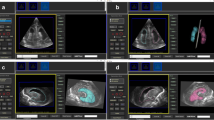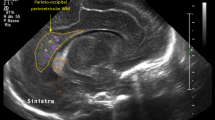Abstract
The developmental outcome at 5 years of age was studied in 93 preterm infants who had been prospectively examined for peri-ventricular leucomalacia (PVL). Standardised neurological examination and developmental assessment, including tests of cognitive function, were carried out. Major sequelae (n=10) could be ascribed in most cases to the presence of large PVL lesions. Children with normal scans (n=51), with isolated haemorrhage (n=15) and with post-haemorrhagic ventricular dilatation (n=3) had a favourable prognosis. Patients with small focal PVL changes (n=16) had lower cognitive abilities on the McCarthy scale and presented more abnormal neuromotor signs and more attention deficits when compared to children with normal scans and isolated haemorrhage. Small focal PVL changes seem therefore to interfere with development at 5 years of age and might represent a morphological marker of a more diffuse brain injury. This study demonstrated also the effect of socioeconomic status on outcome at the age of 5 years.
Similar content being viewed by others
Abbreviations
- GII:
-
general intellectual index
- PVH:
-
periintraventricular haemorrhage
- PVL:
-
periventricular leucomalacia
References
Achenbach TM, Edelbrock C (1983) Manual for the child behaviour checklist and revised child behaviour profile. Department of Psychiatry of the University of Vermont
American Psychiatric Association (1987) Disorders, usually first evident in infancy, in childhood or adolescence. Diagnosis and Statistical Manual of mental disorders, Washington D.C. In: DSM-III-R, pp 27–95
Amiel-Tison C, Grenier A (1986) Neurological assessment during the first year of life. Oxford University Press, New York
Amiel-Tison C, Dube R, Garel M, Jequier JC (1983) Outcome at age five years of full-term infants with transient neurologic abnormalities in the first year of life. In: Stern L, Bard H, Friis-Hansen B (eds) Intensive care in the newborn. Masson, New York, pp 247–258
Appleton RE, Lee REJ, Hey EN (1990) Neurodevelopmental outcome of transient neonatal intracerebral echodensities. Arch Dis Child 65: 27–29
Bjerre I, Hansen E (1976) Psychomotor development and schooladjustment of 7-year-old children with low birthweight. Acta Paediatr Scand 65: 88–96
Bozynski MEA, Nelson MN, Genaze D (1988) Cranial ultrasonography and the prediction of cerebral palsy in infants weighing <1200 grams at birth. Dev Med Child Neurol 30: 342–348
Calame A, Fawer CL, Claeys V, Arrazola L, Ducret S, Jaunin L (1986) Neurodevelopmental outcome and schoolperformance of very-low-birthweight infants at 8 years of age. Eur J Pediatr 145: 461–466
Calvert SA, Hoskins EM, Fong KW, Forsyth SC (1986) Periventricular leucomalacia: ultrasonic diagnosis and neurological outcome. Acta Paediatr Scand 75: 489–496
Cooke RWI (1987) Early and late cranial ultrasonographic appearances and outcome in very low birthweight infants. Arch Dis Child 62: 931–937
Costello AM de L, Hamilton PA, Baudin J, Touwnsend J, Bradford BC, Stewart AL, Reynolds EOR (1988) Prediction of neurodevelopmental impairment at four years from brain ultrasound appearance of very preterm infants. Dev Med Child Neurol 30: 711–722
De Vries LS, Regev R, Pennock JM, Wigglesworth JS, Dubowitz LMS (1988) Ultrasound evolution and later outcome of infants with periventricular densities. Early Hum Dev 16: 225–233
Fawer CL, Calame A, Perentes E, Anderegg A (1985) Periventricular leucomalacia: a correlation study between realtime ultrasound and autopsy findings. Neuroradiology 27: 292–300
Fawer CL, Diebold P, Calame A (1987) Periventricular leucomalacia and neurodevelopmental outcome in preterm infants. Arch Dis Child 62: 30–36
Fuller PW, Guthrie RD, Alvord EC (1983) A proposed neuropathological basis for learning disabilities in children born prematurely. Dev Med Child Neurol 25: 214–231
Gillberg C, Rasmussen P (1982) Perceptual, motor and attentional deficits in seven-year-old children: background factors. Dev Med Child Neurol 24: 752–770
Gillberg IC (1985) Children with minor neurodevelopmental disorders. III: neurological and neurodevelopmental problems at age 10. Dev Med Child Neurol 27: 3–16
Graham M, Levene MI, Trounce JQ, Rutter N (1987) Prediction of cerebral palsy in very low brithweight infants: prospective ultrasound study. Lancet II: 593–596
Grant WM, Boelsche AR, Zin D (1973) Development patterns of two motor functions. Dev Med Child Neurol 15: 171–177
Griffiths R (1954) The abilities of babies: a study in mental measurement. Association for Research in Infant and Child Development, Amersham
Guzzetta F, Shackelford GD, Volpe S, Perlman JM, Volpe JJ (1986) Periventricular intraparenchymal echodensities in the premature newborn: critical determinant of neurologic out-come. Pediatrics 78: 995–1006
Hadders-Algra M, Touwen BCL, Huisjes HJ (1986) Neurologically deviant newborns: neurological and behavioural development at the age of six years. Dev Med Child Neurol 28: 569–578
Hadders-Algra M, Huisjes HJ, Touwen BCL (1988) Preterm or small-for-gestational-age infants. Neurological and behavioural development at the age of 6 years. Eur J Pediatr 147: 460–467
Hertzig ME (1981) Neurological “soft” signs in low-birthweight children. Dev Med Child Neurol 23: 778–791
Hope PL, Gould SJ, Howard S, Hamilton PA, Costello AM de L, Reynolds EOR (1988) Precision of ultrasound diagnosis of pathologically verified lesions in the brains of very preterm infants. Dev Med Child Neurol 30: 457–471
Ingram TTS (1964) Definition and classification of cerebral palsy. In: Paediatric aspect of cerebral palsy. Churchill Livingston, Edinburgh
Kitchen WH, Ryan MM, Rickards A, McDougall AB, Billson FA, Keir EH, Naylor FD (1980) A longitudinal study of very low-birthweight infants. IV: an overview of performance at eight years of age. Dev Med Child Neurol 22: 172–188
Largo RH, Pfister D, Molinari L, Kundu S, Lipp A, Duc G (1989) Significance of prenatal, perinatal and postnatal factors in the development of AGA preterm infants at five to seven years. Dev Med Child Neurol 31: 440–456
Leech RW, Alvord EC (1974) Morphologic variations in periventricular leucomalacia. Am J Pathol 74: 591–602
Levene MI (1981) Measurement of the growth of the lateral ventricles in preterm infants with real time ultrasound. Arch Dis Child 56: 900–904
Levene MI, Fawer CL, Lamont RF (1982) Risk factors in the development of intraventricular haemorrhage in the preterm neonate. Arch Dis Child 57: 410–417
McCarthy P (1972) McCarthy scale of children's abilities. Psychological Corporation, New York
McMenamin JB, Schackelford GD, Volpe JJ (1984) Outcome of neonatal intraventricular haemorrhage with periventricular echodense lesions. Ann Neurol 15: 285–290
Michelsson K, Noronen M (1983) Neurological, psychological and articulary impairment in five-year-old children with a birthweight of 2000 g or less. Eur J Pediatr 141: 96–100
Nwaesei CG, Allen AC, Vincer MJ (1988) Effect of timing of cerebral ultrasonography on the prediction of later neurodevelopmental outcome in high-risk preterm infants. J Pediatr 112: 970–975
Shaywitz SE, Shaywitz BA, Fletcher J, Shupack H (1986) Evaluation of school performance: dyslexia and attention deficit disorder. Pediatrician 13: 96–107
Sheridan MD (1968) Manual for the STYCAR hearing test. NFER Publishing Company Ltd, Berkshire, England
Sheridan MD (1969) Manual for the STYCAR vision test. NFER Publishing Company Ltd, Berkshire, England
Stewart AL, Hope PL, Hamilton PA, Costello AM de L, Baudin J, Bradford BC, Amiel-Tison C, Reynolds EOR (1988) Prediction in very preterm infants of satisfactory neurodevelopmental progress at 12 months. Dev Med Child Neurol 30: 53–63
Stewart AL, Costello AM de L, Hamilton PA, Baudin J, Townsend J, Bradford BC, Reynolds EOR (1989) Relationship between neurodevelopmental status of very preterm infants at one and four years. Dev Med Child Neurol 31: 756–765
Touwen BCL (1979) The examination of the child with minor neurological dysfunction, 2nd edn. Clinics in Developmental Medicine, No. 71. London: S.I.M.P. with Heinemann Medical, Philadelphia
Vohr BR, Garcia Coll CT (1985) Neurodevelopmental and schoolperformance of very low-birthweight in infants: a seven-year longitudinal study. Pediatrics 76: 345–350
Weindling AM, Rochefort MJ, Calvert SA, Fok TF, Wilkinson A (1985) Development of cerebral palsy after ultrasonographic detection of periventricular cysts in the newborn. Dev Med Child Neurol 27: 800–806
Author information
Authors and Affiliations
Rights and permissions
About this article
Cite this article
Fawer, C.L., Calame, A. Significance of ultrasound appearances in the neurological development and cognitive abilities of preterm infants at 5 years. Eur J Pediatr 150, 515–520 (1991). https://doi.org/10.1007/BF01958437
Received:
Accepted:
Issue Date:
DOI: https://doi.org/10.1007/BF01958437




